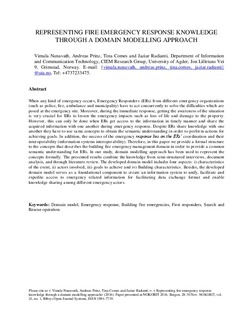| dc.description.abstract | When any kind of emergency occurs, Emergency Responders (ERs) from different emergency organizations (such as police, fire, ambulance and municipality) have to act concurrently to solve the difficulties which are posed at the emergency site. Moreover, during the immediate response, getting the awareness of the situation is very crucial for ERs to lessen the emergency impacts such as loss of life and damage to the property. However, this can only be done when ERs get access to the information in timely manner and share the acquired information with one another during emergency response. Despite ERs share knowledge with one another they have to use same concepts to obtain the semantic understanding in order to perform actions for achieving goals. In addition, the success of the emergency response lies on the ERs’ coordination and their interoperability (information systems interoperability). Therefore, in this paper we provide a formal structure to the concepts that describes the building fire emergency management domain in order to provide a common semantic understanding for ERs. In our study, domain modelling approach has been used to represent the concepts formally. The presented results combine the knowledge from semi-structured interviews, document analysis, and through literature review. The developed domain model includes four aspects: i) characteristics of the event, ii) actors involved, iii) goals to achieve and iv) Building characteristics. Besides, the developed domain model serves as a foundational component to create an information system to unify, facilitate and expedite access to emergency related information for facilitating data exchange format and enable knowledge sharing among different emergency actors. | |
